Latest Posts

By Erik Hjermstad, VP of Product Management for Experian Automotive In today's digital landscape, where consumers increasingly turn to connected TV and addressable TV for entertainment, precision targeting has become more critical than ever for automotive advertisers. By delivering highly relevant ads to the most likely potential customers, advertisers can maximize campaign effectiveness, increase conversion rates, and ultimately drive a better return on investment (ROI). The following is a summary from a recent article I wrote for Ad Age. The Power of Precision Targeting Precision targeting allows advertisers to focus their efforts on the right people with the right message at the right time. This targeted approach helps minimize wasted ad spend and ensures that every dollar invested makes a meaningful impact. By understanding an audience's demographics, interests, and behaviors, automotive marketers can tailor their messaging to resonate with specific consumer segments and pointedly reach those ready to purchase. Leveraging Data Intelligence for Competitive Advantage To stay competitive, automotive marketers must stay on top of the latest data intelligence. Agencies and marketers have turned to data-driven strategies to set their campaigns apart and increase the likelihood of a consumer purchasing a vehicle. When choosing their consumer audiences, automotive marketers turn to companies like Experian Automotive for data like license, registration, and title. They utilize models based on actual vehicle sales and ownership to target the right audience and measure effectiveness more accurately. Measuring Success: Key Metrics and Omnichannel Measurement To ensure that advertising campaigns deliver results, automotive marketers must have a robust measurement strategy. This involves tracking key metrics such as: Sales: Did the buyer purchase a vehicle? Impressions: The number of times an ad is seen. Clicks: The number of times an ad is clicked on. Conversions: The number of people who take a desired action, such as purchasing. Cost per acquisition (CPA): The cost of acquiring a new customer. Return on ad spend (ROAS): The revenue generated by an ad campaign divided by the cost of the campaign. Experian Automotive offers advertisers a robust measurement solution that provides omnichannel measurement, connecting website visitation and ad exposures to automotive sales. Analysis includes make, model, and vehicle class reporting, competitive analysis, and 30-, 60-, and 90-day vehicle sales projections. The Importance of Omnichannel Measurement In today's interconnected world, automotive consumers interact with brands across multiple channels, including TV, digital, social media, and in-store. Advertisers must adopt an omnichannel measurement approach to truly understand their audience and measure the effectiveness of their campaigns. By tracking consumer behavior across all channels, advertisers can gain a more complete picture of the customer journey and identify opportunities for optimization. Omnichannel measurement integrates data from various sources, such as website analytics, social media metrics, and point-of-sale data. This allows advertisers to understand how consumers interact with their brand at different stages of the buying process and attribute conversions to specific channels and touchpoints. By leveraging omnichannel measurement, advertisers can make more informed decisions about their marketing investments and deliver a more cohesive and personalized customer experience. Measurement is critical to advertising success for several reasons: Optimization: By tracking key metrics, advertisers can identify what is working versus what is not and make necessary adjustments to improve campaign performance. Attribution: Measurement helps determine which marketing channels and tactics drive the most conversions. ROI analysis: By measuring the ROI of their campaigns, advertisers can justify their marketing investments and demonstrate the value they bring to the business. Navigating the Challenges of the Streaming Era While precision targeting and measurement are essential in the streaming era, advertisers face unique challenges. The fragmented nature of the streaming landscape, with its multiple platforms and devices, can make it challenging to track consumer behavior and measure campaign effectiveness. However, advancements in data technology and measurement tools provide advertisers with many new opportunities to overcome these challenges. By leveraging data intelligence, using deterministic data models to understand their audience, and tracking key metrics, advertisers can deliver highly relevant ads that drive results and maximize their ROI.

How can lenders ensure they’re making the most accurate and fair lending decisions? The answer lies in consistent model validations. What are model validations? Model validations are vital for effective lending and risk-based pricing programs. In addition to helping you determine which credit scoring model works best on your portfolio, the performance (odds) charts from validation results are often used to set score cutoffs and risk-based pricing tiers. Validations also provide the information you need to implement a new score into your decisioning process. Factors affecting model validations Understanding how well a score predicts behavior, such as payment delinquency or bankruptcy, enables you to make more confident lending decisions. Model performance and validation results can be impacted by several factors, including: Dynamic economic environment – Shifts in unemployment rates, interest rate hikes and other economic indicators can impact consumer behavior. Regulatory changes affecting consumers – For example, borrowers who benefited from a temporary student loan payment pause may face challenges as they resume payments. Scorecard degradation – A model that performed well several years ago may not perform as well under current conditions. When to perform model validations The Office of the Comptroller of the Currency’s Supervisory Guidance on Model Risk Management states model validations should be performed at least annually to help reduce risk. The validation process should be comprehensive and produce proper documentation. While some organizations perform their own validations, those with fewer resources and access to historical data may not be able to validate and meet the guidance recommendations. Regular validations support compliance and can also give you confidence that your lending strategies are built on solid, current data that drive better outcomes. Good model validation practices are critical if lenders are to continue to make data-driven decisions that promote fairness for consumers and financial soundness for the institution. Make better lending decisions If you’re a credit risk manager responsible for the models driving your lending policies, there are several things you can do to ensure that your organization continues to make fair and sound lending decisions: Assess your model inventory. Ensure you have comprehensive documentation showing when each model was developed and when it was last validated. Validate the scores you are using on your data, along with those you are considering, to compare how well each model performs and determine if you are using the most effective model for your needs. Produce validation documentation, including performance (odds) charts and key performance metrics, which can be shared with regulators. Utilize the performance charts produced from the validation to analyze bad rates/approval rates and adjust cutoff scores as needed. Explore alternative credit scoring models to potentially enhance your scoring process. As market conditions and regulations continue to evolve, model validations will remain an essential tool for staying competitive and making sound lending decisions. Ready to ensure your lending decisions are based on the latest data? Learn more about Experian’s flexible validation services and how we can support your ongoing success. Contact us today to schedule a consultation. Learn more

The advent of artificial intelligence (AI) is significantly transforming the landscape of real estate fraud, enabling criminals to execute complex schemes like deed theft with greater ease. A notable case involves Spelling Manor, a $137.5 million mansion in Los Angeles, where the owner alleges they are entangled in deed fraud. Scammers reportedly filed fraudulent documents that have prevented the owner from selling the estate, thwarting offers from buyers, including former Google CEO Eric Schmidt. Understanding deed/title fraud Deed fraud, also known as title or property fraud, occurs when someone illegally transfers ownership of a property without the owner’s knowledge or consent. Typically, fraudsters create fake documents or forge the owner’s signature on a deed to make it look like the property has been legally transferred to them. Once the title is in their name, they may try to sell or mortgage the property, leaving the original owner unaware until it’s too late. How deed fraud works Identify a target: Fraudsters often look for properties that appear vulnerable, such as vacant land, unoccupied homes, or properties owned by elderly individuals who may not check their records frequently. Forge documentation: Using fake IDs and forged signatures, scammers create documents that appear to show a legitimate transfer of ownership. With modern technology, these documents can look highly convincing. Record the fake deed: Fraudsters then file these documents with the local county clerk or recorder’s office. This officially changes the ownership records, making it seem as if the scammer is the legitimate owner. Exploit the ownership: Once listed as the owner, the fraudster may sell the property to an unsuspecting buyer, take out loans against it, or even rent it out. The impact on victims In the summer of 2024, Elvis Presley’s family got confronted to a forged deed scam. A fake firm, Naussany Investments, falsely claimed Lisa Marie Presley owed millions and used Graceland as collateral. They placed a foreclosure notice and attempted to auction the estate. Riley Keough filed a lawsuit, exposing the firm as fraudulent and halting the foreclosure through a judge’s injunction. Lisa Jeanine Findley, who forged documents and posed as firm employees, was arrested and charged with deed forgery fraud and identity theft. She faces up to 22 years in prison if convicted. The FBI's Internet Crime Complaint Center does not specifically monitor deed fraud. However, in 2023, it processed a total of 9,521 real estate-related complaints defined as the loss of funds from a real estate investment, resulting in more than $145 million in losses. Victims of deed fraud can face severe financial and legal issues. They may discover the fraud only when trying to sell, refinance, or even pay taxes on the property. Reversing deed fraud typically requires a costly and time-consuming legal process, as courts must determine that the transfer was fraudulent and restore the original owner’s rights. Prevention and safeguards There are several preventive measures and fraud prevention solutions that can be established to help mitigate the risks associated with deed/title fraud. These include: For lending institutions: Enhanced ID verification: Implement multi-factor identity checks at the loan approval stage. Regular portfolio audits: Conduct periodic audits to detect unusual property transfers and title changes in their loan portfolios. For title companies: AI-driven document verification tools: Use machine learning algorithms to identify inconsistencies in deed and ownership documents. Real-time fraud monitoring: Employ analytics to track suspicious behavior patterns, such as rapid ownership changes. Seller authentication: Require biometric or multi-step identity verification for anyone claiming ownership or initiating sales. For realtors: Training and awareness: Educate realtors on how to spot warning signs of fraudulent listings and seller impersonations. Pre-transaction verification: Collaborate with title companies to validate ownership early in the listing process. Acting with the right solution Mortgage fraud is a constant threat that demands ongoing vigilance and adaptability. As fraudsters evolve their tactics, the mortgage industry must stay one step ahead to safeguard homeowners and lenders alike. With concerns over deed/title-related fraud rising, it is vital to raise awareness, strengthen preventive measures, and foster collaboration to protect the integrity of the mortgage market. By staying informed and implementing robust safeguards, we can collectively combat and prevent mortgage fraud from disrupting the financial security of individuals and the industry. Experian mortgage powers advanced capabilities across the mortgage lifecycle by gaining market intelligence, enhancing customer experience to remove friction and tapping into industry leading data sources to gain a complete view of borrower behavior. Visit our website to see how these solutions can help your business prevent deed fraud. Learn more

In today's data-driven business landscape, leveraging advanced targeting techniques is crucial for effective consumer engagement, particularly in the financial services sector. Prescreen targeting solutions have evolved significantly, offering a competitive edge through more precise and impactful outreach strategies. The power of data analytics and predictive modeling At the heart of modern prescreen targeting solutions lies the integration of extensive data analytics and predictive modeling. These systems combine detailed consumer information, including purchasing behaviors and credit scores, with sophisticated algorithms to identify potential customers most likely to respond positively to specific promotional campaigns. This approach not only streamlines campaign efforts but also enhances the tactical effectiveness of each interaction. Direct mail: a proven channel for financial services In the competitive North American financial services market, direct mail has demonstrated distinct advantages as a targeting channel. Its tangible nature helps cut through digital noise, capturing consumer attention effectively. For credit products, direct mail typically achieves engagement rates of 0.2-2% for prime consumers and 1-3% for near-prime and subprime consumers[1]. Key advantages of prescreen targeting solutions Enhanced response rates Custom response models can significantly boost prospect response rates by targeting a well-defined, high-propensity audience. These models have the potential to improve average response rates of prescreen direct mail campaigns by 10-25%. Risk mitigation By focusing on well-defined, high-propensity audiences, prescreen targeting via direct mail aims to attract the right prospects, minimizing fraud and delinquency risks. This targeted approach can lead to substantial savings on underwriting costs. Improved customer engagement and retention Personalized direct mail strengthens customer relationships by making recipients feel valued, leading to higher engagement and loyalty – crucial factors for long-term business success. Regulatory compliance and security Prescreen solutions come equipped with compliance safeguards, simplifying adherence to industry regulations and consumer privacy standards. This is particularly critical in the highly regulated financial sector. The future of targeting and enhancement As markets continue to evolve, the strategic importance of precise and efficient marketing techniques will only grow. Financial institutions leveraging optimized prescreen targeting and enhancement solutions can gain a significant competitive advantage, achieving higher immediate returns and fostering long-term customer loyalty and brand strength. Future advancements in AI and machine learning are expected to further refine prescreen targeting capabilities, offering even more sophisticated tools for marketers to engage effectively with their target audiences. Ascend Intelligence Services™ Target Ascend Intelligence Services Target is a sophisticated prescreening solution that boosts direct mail response rates. It uses comprehensive trended and alternative data, capturing credit and behavior patterns to iterate through direct mail response models and mathematical optimization. This enhances the target strategy and maximizes campaign response, take-up rates, and ROI within business constraints. Visit our website to learn more [1] Experian Research, Data Science Team, July 2024

The risk of identity theft continues to grow yearly for consumers and businesses alike. Identity theft and fraud cases have nearly tripled over the past ten years, with cybercrime losses totaling more than $10 billion this year alone.[1] An effective way for organizations to combat these threats is to implement a policy of identity risk management. Identity risk management Identity risk management refers to the methods used by organizations to anticipate potential fraud threats, protect themselves and their consumers from those vulnerabilities, resolve any fraud incidents that may occur, and prevent future fraud events from happening again. Businesses can implement these methods through a variety of tools and technologies designed to detect fraud risks and mitigate them as quickly and efficiently as possible. By recognizing the risks of identity theft, helping consumers who fall victim to fraud, and preventing identity theft in the future, financial institutions can take an effective approach to identity risk management and ensure that their business is protected and their consumers stay safe. Recognizing risks of identity theft Identifying high-risk situations Inform consumers about high-risk situations that could lead to identity theft. Emphasize the dangers of data breaches, cyber-attacks, phishing scams, and social engineering tactics. Advise them to be cautious with personal documents and to avoid using public Wi-Fi for sensitive transactions. By raising awareness, financial institutions can help consumers stay vigilant. Risk-based authentication solutions can also help minimize risk with adaptive authentication methods. With sophisticated risk assessment and a combination of front- and back-end authentication methods, organizations can optimize the consumer experience and their identity risk management simultaneously. Protecting vulnerable information Guide consumers on safeguarding their most vulnerable information. Explain the importance of protecting Social Security numbers, credit card and bank account details, PINs, passwords, and medical records. Offer tips on securing this information and the potential consequences of it falling into the wrong hands. Providing practical advice, such as using password managers, enabling multifactor authentication, and regularly updating passwords, can significantly enhance your consumers’ security. Additionally, offering secure storage solutions for sensitive documents can further protect their information. Helping consumers who fall victim to fraud Providing immediate support If a consumer falls victim to identity theft, financial institutions should be ready to provide immediate support. Establish a clear protocol for reporting fraud and ensure that consumer service representatives are trained to handle such situations. Assist consumers in contacting their banks and credit card companies to report fraud and prevent further unauthorized transactions. Having a dedicated fraud response team can streamline this process and provide consumers with the reassurance that their issue is being handled by experts. This team can also offer personalized advice and support, making the recovery process less daunting for the victim. Helping restore identity To support consumers in the process of restoring their identity, financial institutions can offer identity restoration services as part of their consumer support. These services can include helping consumers navigate the complexities of repairing their credit, disputing fraudulent charges, and securing their accounts against future threats. Preventing identity theft in the future Enhancing personal security measures Encourage consumers to strengthen their personal security measures. Promote the use of strong, unique passwords and two-factor authentication (2FA) for all accounts. Advise them to regularly update and patch their software and devices. Offer services like secure document shredding to prevent thieves from accessing sensitive information. Financial institutions can also strengthen their identity risk management efforts by implementing robust security measures within their own systems. Demonstrating a commitment to security can build trust and encourage consumers to adopt similar practices. Implementing monitoring and alerts Financial institutions can offer identity theft protection services that include regular monitoring of credit reports and account alerts for suspicious activities. Educate consumers on the importance of closely monitoring their financial statements and bills to detect any unauthorized transactions early. Providing tools such as mobile apps that offer real-time alerts for suspicious activities can empower consumers to take immediate action if something seems amiss. Additionally, offering complimentary credit monitoring services can add an extra layer of protection. Leveraging data Data and analytics are among the most powerful tools at a financial institution’s disposal. By leveraging advanced analytics, institutions can identify patterns and anomalies that may indicate fraudulent activity. Machine learning algorithms can analyze vast amounts of transaction data in real- time, flagging suspicious behavior before it escalates into fraud. This proactive approach not only helps in early detection but also minimizes the impact on the consumer. Moreover, data analytics can streamline and improve the consumer experience by reducing false positives and ensuring that legitimate transactions are not unnecessarily flagged. This balance between security and convenience is crucial in maintaining consumer trust and satisfaction. Financial institutions can use these insights to tailor their fraud prevention strategies, using digital identity management solutions to provide more value to consumers. Behavioral analytics Fraud detection technology, such as behavioral analytics, is continually evolving as hacking methods become increasingly sophisticated. Insights from behavioral analytics can help mitigate fraud in real time and prevent identity theft, account takeover, and bot attacks — empowering businesses to provide a seamless consumer experience. Experian’s recent acquisition of NeuroID, an industry leader in behavioral analytics, means we now offer even more modern and frictionless capabilities, enhancing our fraud risk suite by providing a new layer of insight into digital behavioral signals and analytics throughout the consumer lifecycle. This additional level of defense against fraud can empower businesses to ensure that their consumers are safe and secure online. Identity management solutions Consumers are more at risk of identity theft than ever before, and it’s the responsibility of financial institutions to provide protection and support to the people they do business with. Offering identity management solutions can help organizations feel safe and secure about their consumer and business data without adding friction or functioning outside of their risk tolerance. Experian’s identity management tools allow financial institutions to confirm the identities of businesses and consumers with minimal friction, balancing end-user experience with enhanced security. This allows organizations to easily manage authentication events with confidence. Next steps Financial institutions have a vital role in helping consumers manage their risk of identity theft. By recognizing vulnerabilities, providing support to victims, and implementing preventive measures, financial institutions can protect their consumers’ personal information and financial well-being. Proactive identity risk management not only benefits consumers but also builds trust and loyalty with your brand. Protect your business from identity fraud today. Discover how Experian’s cutting-edge identity risk management solutions can safeguard your consumers and streamline your operations. Learn more about our identity management solutions This article includes content created by an AI language model and is intended to provide general information. [1] IdentityTheft.org. 2024 Identity Theft Facts and Statistics.
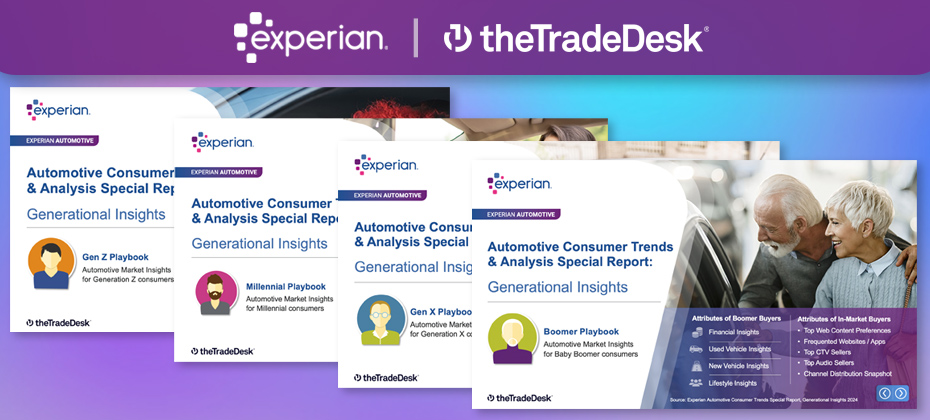
Summary: Gen Z, Millennials, Gen X, and Boomers each have unique automotive buying preferences and your strategies to reach each generation should reflect these preferences. The automotive landscape is shaped by the distinct preferences of different generations. From Gen Z to Boomers, each generation brings unique buying habits that automotive marketers must understand to stay competitive. Below is a brief overview of the key insights from the latest reports on Gen Z, Millennials, Gen X, and Boomers. To learn more about how to market to each generation, download the respective playbook. Gen Z (Born 1996–2015) Gen Z buyers are digital natives who prefer compact vehicles. The Honda Civic leads in market share for this group, showcasing their preference for smaller, fuel-efficient cars. They rely heavily on digital platforms for their research, with 73% of impressions delivered through Connected TV (CTV). Millennials (Born 1981–1995) Millennials value technology and eco-friendly options. Crossovers (CUVs) are their top choice, making up 50.2% of new vehicle registrations. Electric and hybrid vehicles are also popular, reflecting their environmental consciousness. Popular models include the Honda Civic and Toyota RAV4. Gen X (Born 1965–1980) Gen X buyers favor practicality and reliability, gravitating toward SUVs and trucks. The Ford F-150 is the top model among this group, and they are more likely to invest in luxury or exotic vehicles than younger generations. Boomers (Born 1946–1964) Boomers remain loyal to traditional brands, with a strong preference for non-luxury and luxury cars, such as the Honda CR-V and Ford F-150. They also favor gas-powered vehicles over electric, though hybrid options are gaining ground. Summary Understanding generational differences is crucial to developing effective marketing strategies that resonate with each group’s unique preferences. For a more detailed generational analysis, download the full report. Experian Automotive is here to help you with your marketing needs. If you’d like to learn more about our solutions and how we can support you, contact us below.
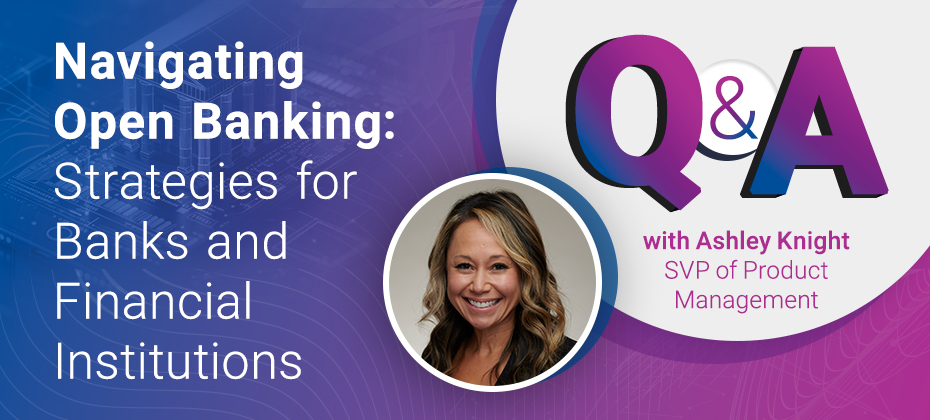
The open banking revolution is transforming the financial services landscape, offering banks and financial institutions unprecedented access to consumer-permissioned data. However, during our recent webinar, “Navigating Open Banking: Strategies for Banks and Financial Institutions,” over 78% of attendees stated that they do not currently have an open banking strategy in place. This highlights a significant gap in the industry. By tapping into consumer-permissioned data, you can develop more personalized products, streamline credit decisioning, and improve overall customer engagement. With the right strategies, open banking offers a pathway to growth, innovation, and enhanced customer experiences. Here’s a snippet from the webinar’s Q&A session with Ashley Knight, Senior Vice President of Product Management, who shared her perspective on open banking trends and opportunities. Q: What specific analytic skill is the most important when working on open banking data?A: The ability to parse and transform raw data, a deep understanding of data mining, experience in credit risk, and general modeling skills to improve underwriting. Q: What lessons did the U.S. learn from the experience of other countries that implemented open banking? A: The use cases are common globally; typical uses of open banking data include second-chance underwriting to help score more consumers and customer management, which involves assessing cashflow data to leverage on an existing portfolio (first-party data). This can be used in various ways, such as cross-sell, up-sell, credit line increase, and growing/retaining deposits. Q: Does Experian have access to all a consumer’s bank accounts in cases where the consumer has multiple accounts?A: Data access is always driven by consumer permission unless the organization owns this data (i.e., first-party data). Where first-party data is unavailable, we collect it through clients or lenders who send it to us directly, having gained the proper consent. Yes, we can intake data from multiple accounts and provide a categorization and attribute calculation. Q: Where does the cashflow data come from? Is it only credit card spending?A: It includes all spending data from bank accounts, checking accounts, credit cards, savings, debit cards, etc. All of this can be categorized, and we can calculate attributes and/or scores based on that data. Q: What is the coverage of Experian’s cashflow data, and how is it distributed across risk bands?A: Cashflow data moves through Experian directly from consumer permissioning for B2B use cases or from institutions with first-party data. We perform analytics and calculate attributes on that portfolio. Don’t miss the chance to learn from our industry leaders on how to navigate the complexities of open banking. Whether you are a seasoned professional or just starting to explore its potential, this webinar will equip you with the knowledge you need to stay ahead. Watch on-demand recording Learn more Meet our expert Ashley Knight, Senior VP of Product Management, Experian Ashley leads our product management team focusing on alternative data, scores, and open banking. She fosters innovation and drives financial inclusion by using new data, such as cash flow, analytics, and Experian’s deep expertise in credit.

In 2023, mobile fraud attacks surged by over 50%.1 With people relying more on mobile devices for day-to-day activities, like banking, shopping and healthcare, fraudsters have found new ways to exploit mobile security. With phones housing such sensitive data, how can businesses ensure that the person on the other end of a mobile device is who they claim to be? Enter mobile identity verification, a process designed to protect consumers and businesses in today’s mobile-driven world. Understanding mobile identity Mobile identity refers to the digital identity associated with a mobile device. This includes information like phone numbers, SIM cards, device IDs and user credentials that uniquely identify a person or device. Verifying that the mobile identity belongs to the correct individual is crucial for secure digital transactions. What is mobile identity verification? Mobile identity verification confirms the legitimacy of users accessing services via their mobile device. This process uses personal data, biometrics and mobile network information to authenticate identity, ensuring businesses interact with real customers without unnecessary friction. Why is mobile identity verification important? The rise of mobile banking, mobile payments and other mobile-based services has increased the need for robust security measures. Cybercriminals have found ways to exploit the mobile ecosystem through SIM swapping, phishing and other fraud tactics. This makes mobile identity verification critical for businesses looking to protect sensitive customer data and prevent unauthorized access. Here are some of the key reasons why mobile identity verification is essential: Preventing fraud: Identity theft and fraud are major concerns for businesses and consumers alike. Mobile identity verification helps to reduce the risk of fraud by ensuring that the user is who they say they are. Enhancing user trust: Customers are more likely to trust a service that prioritizes their security. Businesses that implement mobile identity verification solutions provide an extra layer of protection, which can help build customer confidence. Regulatory compliance: Many industries, including finance and healthcare, are subject to strict regulations concerning data privacy and security. Mobile identity verification helps businesses meet these regulatory requirements by offering a secure way to verify customer identities. Improving user experience: While security is essential, businesses must also ensure that they do not create a cumbersome user experience. Mobile identity verification solutions offer a quick and seamless way for users to verify their identities without sacrificing security. This is especially important for onboarding new users or completing transactions quickly. How does mobile identity verification work? Mobile identity verification involves a combination of different techniques and technologies, depending on the service provider and the level of security required. Some common methods include: Biometric authentication: Biometrics like fingerprint scans, facial recognition and voice recognition are becoming increasingly popular for verifying identities. These methods are secure and convenient for users since they don't require remembering passwords or PINs. SMS-based verification: One-time passwords (OTPs) sent via SMS to a user's mobile phone are still widely used. This method links the verification process directly to the user's mobile device, ensuring that they have possession of their registered phone number. Device-based verification: By analyzing the unique identifiers of a mobile device, such as IMEI numbers, businesses can confirm that the device is registered to the user attempting to access services. This helps prevent fraud attempts from unregistered or stolen devices. Mobile network data: Mobile network operators have access to valuable information, such as the user’s location, SIM card status and network activity. By leveraging this data, businesses can further verify that the user is legitimate and actively using their mobile network as expected. Behavioral analytics: By analyzing patterns in user behavior — such as typing speed, navigation habits, and interactions with apps — mobile identity verification solutions can detect anomalies that might indicate fraudulent activity. For instance, if a user’s behavior demonstrates low-to-no familiarity with the PII they provide, it can trigger an additional layer of verification to ensure security. The role of identity solutions in mobile identity verification Mobile identity verification is just one part of a broader range of identity solutions that help businesses authenticate users and protect sensitive data. These solutions not only cover mobile devices but extend to other digital touchpoints, ensuring that organizations have a holistic, multilayered approach to identity verification across all channels. Companies that provide comprehensive identity verification solutions can help organizations build robust security infrastructures while offering seamless customer experiences. For instance, Experian offers cutting-edge solutions designed to meet the growing demand for secure and efficient identity verification and authentication. These solutions can significantly reduce fraud and improve customer satisfaction. The growing importance of digital identity In the digital age, managing and verifying identities extends beyond traditional physical credentials like driver’s licenses or social security numbers. Digital identity plays an essential role in enabling secure online transactions, personalizing user experiences and protecting individuals' privacy. However, with great convenience comes great responsibility. Businesses need to strike a balance between security and personalization to ensure they protect user data while still offering a smooth customer experience. As mobile identity verification becomes more widespread, it’s clear that safeguarding digital identity is more important than ever. To learn more about the importance of digital identity and how businesses can find the right balance between security and personalization, check out this article: Digital identity: finding the balance between personalization and security. How Experian can help Experian is at the forefront of providing innovative identity verification solutions that empower businesses to protect their customers and prevent fraud. With solutions tailored for mobile identity verification, businesses can seamlessly authenticate users while minimizing friction. Experian’s technology integrates behavioral analytics, device intelligence and mobile network data to create a comprehensive and secure identity verification process. Whether you’re looking for a complete identity verification solution or need specialized mobile identity verification services, Experian’s identity verification and authentication solutions offer the solutions and expertise your organization needs to stay secure in the evolving digital landscape. Learn More 1 Kapersky This article includes content created by an AI language model and is intended to provide general information.
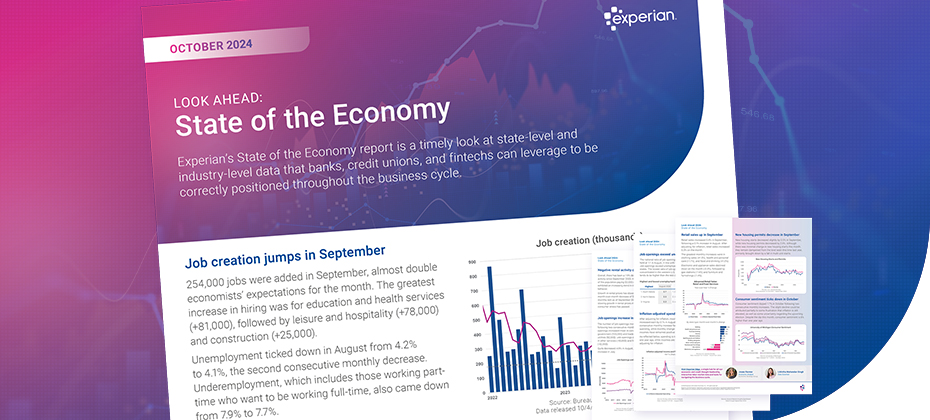
This series will explore our monthly State of the Economy report, which provides a snapshot of the top monthly economic and credit data for financial service professionals to proactively shape their business strategies. After the Federal Reserve announced its first cut since 2020 in September, several pieces of economic data have surpassed expectations. Job creation was almost double economists’ estimates, unemployment ticked down, and personal incomes were revised up. Alongside these areas of strength, inflation continued to prove stubborn. The October State of the Economy report fills in the rest of the developing macroeconomic story. This month’s highlights include: Unemployment decreased for the second month in a row, down to 4.1%. Core inflation increased from 3.2% to 3.3%, driven by shelter and service costs. Negative rental payment activity has declined 1.9% over the past year. Check out our report for a detailed analysis of the rest of this month’s data, including the latest trends in originations, retail sales, and consumer sentiment. Download October's report As our economy continues to fluctuate, it's critical to stay updated on the latest developments. Subscribe to our new series, The Macro Moment, for economic commentary from Experian NA’s Chief Economist, Joseph Mayans, with additional economic resources, including our new Lending Conditions Chartbook and our new Labor Market Monitor. For more economic trends and market insights, visit Experian Edge.

U.S. federal prosecutors have indicted Michael Smith of North Carolina for allegedly orchestrating a $10 million fraud scheme involving AI-generated music. Smith is accused of creating fake bands and using AI tools to produce hundreds of tracks, which were streamed by fake listeners on platforms like Spotify, Apple Music, and Amazon Music. Despite the artificial engagement, the scheme generated real royalty payments, defrauding these streaming services. This case marks the first prosecution of its kind and highlights a growing financial risk: the potential for rapid, large-scale fraud in digital platforms when content and engagement can be easily fabricated. A new report from Imperva Inc. highlights the growing financial burden of unsecure APIs and bot attacks on businesses, costing up to $186 billion annually. Key findings highlight the heavy economic burden on large companies due to their complex and extensive API ecosystems, often unsecured. Last year, enterprises managed about 613 API endpoints on average, a number expected to grow, increasing associated risks. APIs exposure to bot attacks Bot attacks, similar to those seen in streaming fraud, are also plaguing financial institutions. The risks are significant, weakening both security and financial stability. 1. Fraudulent transactions and account takeover Automated fraudulent transactions: Bots can perform high volumes of small, fraudulent transactions across multiple accounts, causing financial loss and overwhelming fraud detection systems. Account takeover: Bots can attempt credential stuffing, using compromised login data to access user accounts. Once inside, attackers could steal funds or sensitive information, leading to significant financial and reputational damage. 2. Synthetic identity fraud Creating fake accounts: Bots can be used to generate large numbers of synthetic identities, which are then used to open fake accounts for money laundering, credit fraud, or other illicit activities. Loan or credit card fraud: Using fake identities, bots can apply for loans or credit cards, withdrawing funds without intent to repay, resulting in significant losses for financial institutions. 3. Exploiting API vulnerabilities API abuse: Just as bots exploit API endpoints in streaming services, they can also target vulnerable APIs in financial platforms to extract sensitive data or initiate unauthorized transactions, leading to significant data breaches. Data exfiltration: Bots can use APIs to extract financial data, customer details, and transaction records, potentially leading to identity theft or data sold on the dark web. Bot attacks targeting financial institutions can result in extensive fraud, data breaches, regulatory fines, and loss of customer trust, causing significant financial and operational consequences. Safeguarding financial integrity To safeguard your business from these attacks, particularly via unsupervised APIs, a multi-layered defense strategy is essential. Here’s how you can protect your business and ensure its financial integrity: 1. Monitor and analyze data patterns Real-time analytics: Implement sophisticated monitoring systems to track user behavior continuously. By analyzing user patterns, you can detect irregular spikes in activity that may indicate bot-driven attacks. These anomalies should trigger alerts for immediate investigation. AI, machine learning, and geo-analysis: Leverage AI and machine learning models to spot unusual behaviors that can signal fraudulent activity. Geo-analysis tools help identify traffic originating from regions known for bot farms, allowing you to take preventive action before damage occurs. 2. Strengthen API access controls Limit access with token-based authentication: Implement token-based authentication to limit API access to verified applications and users. This reduces the chances of unauthorized or bot-driven API abuse. Control third-party integrations: Restrict API access to only trusted and vetted third-party services. Ensure that each external service is thoroughly reviewed to prevent malicious actors from exploiting your platform. 3. Implement robust account creation procedures PII identity verification solutions: Protect personal or sensitive data through authenticating someone`s identity and helping to prevent fraud and identity theft. Email and phone verification: Requiring email or phone verification during account creation can minimize the risk of mass fake account generation, a common tactic used by bots for fraudulent activities. Combating Bots as a Service: Focusing on intent-based deep behavioral analysis (IDBA), even the most sophisticated bots can be spotted, without adding friction. 4. Establish strong anti-fraud alliances Collaborate with industry networks: Join industry alliances or working groups that focus on API security and fraud prevention. Staying informed about emerging threats and sharing best practices with peers will allow you to anticipate new attack strategies. 5. Continuous customer and account monitoring Behavior analysis for repeat offenders: Monitor for repeat fraudulent behavior from the same accounts or users. If certain users or transactions display consistent signs of manipulation, flag them for detailed investigation and potential restrictions. User feedback loops: Encourage users to report any suspicious activity. This crowd-sourced intelligence can be invaluable in identifying bot activity quickly and reducing the scope of damage. 6. Maintain transparency and accountability Audit and report regularly: Offer regular, transparent reports on API usage and your anti-fraud measures. This builds trust with stakeholders and customers, as they see your proactive steps toward securing the platform. Real-time dashboards: Provide users with real-time visibility into their data streams or account activities. Unexplained spikes or dips can be flagged and investigated immediately, providing greater transparency and control. Conclusion Safeguarding your business from bot attacks and API abuse requires a comprehensive, multi-layered approach. By investing in advanced monitoring tools, enforcing strict API access controls, and fostering collaboration with anti-fraud networks, your organization can mitigate the risks posed by bots while maintaining credibility and trust. The right strategy will not only protect your business but also preserve the integrity of your platform. Learn more

The Fed finally made their long-awaited rate cut. Hooray! The industry is saved! Brush off the dust everyone, it’s time to start originating mortgages like it’s 2006 again! Not so fast. While it's true that there are opportunities to take advantage of now that rates have declined, there remain open questions: How much further will rates decline? So far, only this single drop has been signaled. How many customers will realize benefit from a rate & term refinance offer given the rate drop(s)? What does this rate drop mean for the purchase market given that home prices remain at all-time highs? To put it simply, there are lending opportunities for home lenders (mortgage and home equity), but only for those with the ability to effectively leverage data and analytical strategies to identify and execute on the pockets of opportunity. By “pockets of opportunity,” we mean the following categories of consumers will benefit from specific mortgage or home equity offers. Rate & term refi: According to Experian research, over 83% of mortgages have an interest rate below 6.5%. This means that only the loans originated in the past couple of years (including one held by your author) will be eligible for a rate & term refi. The dollar amount on these loans will be high along with the interest rates, so even a minor savings on the interest rate will translate to potentially hundreds of thousands of dollars in lifetime interest savings for the borrowers. Being able to accurately identify which borrowers have an interest rate that is higher than the rate you can offer them is key to efficiently targeting and originating rate & term refinances. Cashout refi: Equity levels exploded over the past several years for homeowners. Home prices show no sign of slowing down and home equity continues to be a significant, and in many cases untapped, financial resource for borrowers. A cashout refi is an excellent option for those consumers with high amounts of available equity in their homes. Some borrowers may choose to originate a cashout refinance loan even if the interest rate is similar to their existing rate, such is the value of partially liquidating their equity position. Having the consumer-level data to identify what equity positions are and the current interest rate is crucial to crafting personalized, effective marketing offers. The ability to target qualified customers with a personalized offer is critical given that in August 2024, over 2.9 million cashout direct mail offers were mailed to consumers.1 Streamlined refi: The VA and FHA have streamlined refinance programs that minimize the consumer lift to refinance their loan. Additionally, there are also non-VA and FHA loans that could benefit from what is called an “Express Title,” which removes the need for a full title workup and expedites the originations process. Borrowers that meet the criteria for these streamlined refinance offers can be identified using credit data. Since these refinances are easier for consumers, they will be more likely to respond and book a refinance offer, which means more ROI for your marketing spend. Home equity lines/loans: Similar to cashout refi, home equity products are an option for consumers to access the equity they have in their price-appreciated homes. Although this is no mystery to most lenders, many lenders do not leverage adequate data or analytics to identify the needle in the haystack of customers that still remain to be targeted. Experian data shows over $25B in monthly HELOC originations as of August 2024. Understanding which consumers have a second lien position available, how much equity they have by leveraging trade-level mortgage data and Automated Valuation Model (AVM) data, and other methods can help your home equity products stand out from the sea of offers in the mail and online. At Experian, we help our clients target and originate all four categories of borrowers: rate & term refinancers, cashout refinancers, streamlined refinancers, and home equity borrowers. Crafting a marketing strategy with the accurate data to precisely identify which consumers qualify for which product is crucial to making the most of your marketing spend. Without the guidance of such data and the personalized offers they enable, your marketing message is liable to be lost among all of the other direct mail and email blasts. Market with confidence Crafting an effective holistic marketing strategy across these segments is crucial to campaign success. Consider these borrower situations and prepare to respond with confidence: Does the consumer have a high interest rate? Would the consumer benefit from a quick rate & term refi? If yes, ship the offer out. Does the consumer have a significant equity position and outstanding revolving debt balances, but not qualify for a rate & term due to a relatively low rate? If yes, ship them a cashout refi offer with language about using their equity to pay off revolving debt. Does the consumer meet the criteria for a streamlined refi, and would they benefit financially from such an offer? If yes, ship them a VA IRRRL (Interest Rate Reduction Refinance Loan), FHA streamline, or an offer to cover their refi title expenses if they qualify for an express title. Does the consumer have an open second lien on their primary residence, but not qualify for either kind of refi? If yes, ship them a home equity offer. By creating this kind of specialized marketing waterfall, lenders can ensure they have valuable offers for all borrowers, not just for a specialized market. Such strategies allow you to target your existing portfolio or a prospect population to facilitate portfolio growth and prevent portfolio attrition. Be sure to join our upcoming webinar, "Return of the Refi: Top Lending Strategies for Becoming a Refi Master." Register now and learn more about how Experian can help you win more mortgage and home equity customers in this declining rate environment. Register now Learn more 1 Mintel data
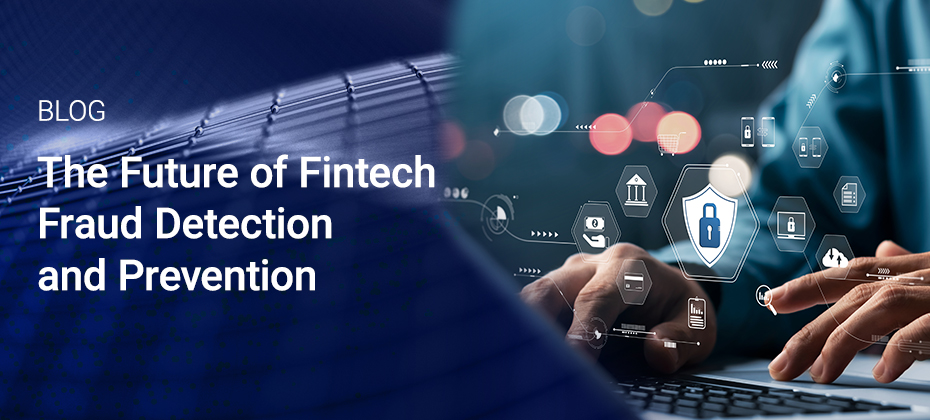
In this article...Understanding the scope of fintech fraudThe importance of fintech fraud preventionSynthetic identity (ID) fraud: A growing threatHow fintech fraud detection and prevention are evolvingGet started today The integration of technology with traditional financial services has unlocked unprecedented convenience and opportunities for consumers and businesses alike. However, this digital shift has opened the door for more sophisticated fraud tactics. With fraudsters continuously refining their methods, fintech companies must invest in advanced fintech fraud detection and prevention solutions. Understanding the scope of fintech fraud As fintech platforms expand, they also attract the attention of cybercriminals. The accessibility of digital financial services can create vulnerabilities that fraudsters exploit, executing everything from personal account takeovers to larger-scale breaches involving synthetic identities. Source: Experian’s 2024 U.S. Identity & Fraud Report To counter these threats, fintech companies must deploy innovative fraud management solutions powered by artificial intelligence (AI), machine learning (ML), and advanced analytics. Unlike traditional methods that often rely on static rules and manual reviews, these solutions can process vast amounts of data, learn from historical patterns, and detect anomalies in real-time. This allows organizations to identify suspicious activities before they lead to significant losses. The importance of fintech fraud prevention While detecting fraud is crucial, preventing it from occurring in the first place is even more important. Fraud prevention solutions aim to create robust systems that stop fraudsters in their tracks before they can cause damage. With the rise of digital financial services, the need for proactive fraud prevention measures has never been greater. These solutions protect both consumers and businesses from financial harm, reducing the risk of financial loss and reputational damage. Advanced fraud prevention solutions employ multi-layered strategies, combining AI-driven fraud detection tools with methods such as multifactor authentication and biometric identity verification. These tools create an extra layer of security, making it difficult for fraudsters to access sensitive data or execute fraudulent transactions. Experian’s fraud prevention solutions offer businesses a comprehensive suite of tools designed to prevent various types of fraud. From real-time transaction monitoring to sophisticated user authentication methods, these solutions provide the protection businesses need to stay ahead of evolving fraud tactics. Synthetic identity (ID) fraud: A growing threat One of the most concerning forms of fraud that fintech companies face is synthetic ID fraud. This type of fraud involves the creation of a fake identity using a combination of real and fabricated information. Fraudsters often steal pieces of personal data—such as Social Security numbers or addresses—and then combine them with fictional information to create a new, synthetic identity. These synthetic identities can be used to open bank accounts, apply for credit cards, or take out loans, leaving businesses and consumers vulnerable to significant financial losses. Synthetic ID fraud is particularly difficult to detect because the synthetic identity often looks legitimate to traditional verification systems. As a result, fintech companies must deploy sophisticated fraud detection systems that can identify synthetic identities before they’re used to commit fraud. Machine learning algorithms, for instance, can analyze behavioral data, detecting discrepancies that may indicate a synthetic identity. Experian is ranked #1 by the Center for Financial Professionals (CeFPro®) for Identity and Fraud. The ranking appeared in CeFPro’s Fintech Leaders Report, a comprehensive annual study of the fintech industry. How fintech fraud detection and prevention are evolving As fraudsters continue to evolve their tactics, fintech companies must remain one step ahead by investing in cutting-edge fraud detection and prevention technologies. Real-time monitoring, predictive analytics, and biometrics are just a few of the technologies shaping the future of fraud detection. By integrating these technologies into their fraud management processes, fintech companies can offer a more secure and seamless experience for their users. With the acquisition of NeuroID, an industry leader in behavioral analytics, Experian has amplified its fraud risk suite by providing a new layer of insight into digital behavioral signals and analytics. Available through our fraud solutions on the Experian Ascend Technology PlatformTM, clients can proactively monitor and analyze a user’s real-time digital behavior, allowing them to confidently navigate the online landscape and provide frictionless customer experiences. Get started today As the fraud landscape continues to evolve, fintech companies must adopt comprehensive solutions to stay ahead of emerging threats. By doing so, they can protect themselves and their customers, ensuring the continued success of digital financial services in the years to come. To learn more, check out our fraud management and fintech solutions. Fraud management solutions Fintech solutions This article includes content created by an AI language model and is intended to provide general information. In this article...
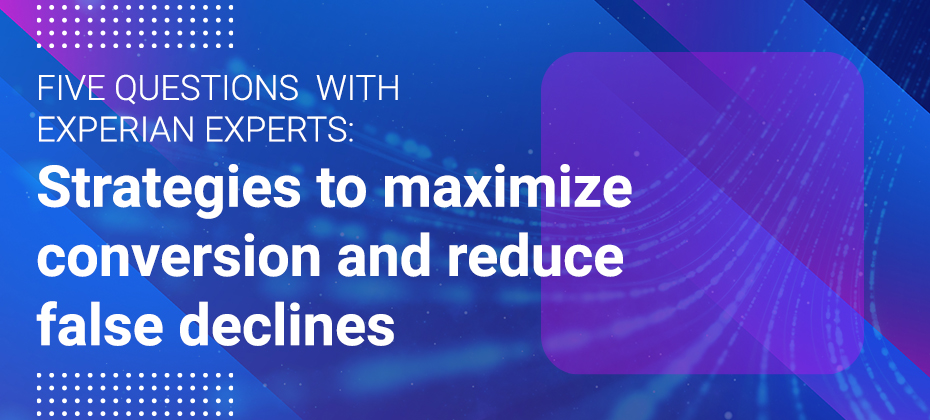
Online fraud has increased exponentially over the past few years, with the Federal Trade Commission (FTC) data showing that consumers reported losing more than $10 billion to fraud in 2023. This marks the first time that fraud losses have reached that benchmark, and it’s a 14% increase over reported losses in 2022. As a result, e-commerce merchants and retailers have reacted by adding friction to e-commerce interactions. The risk is that a legitimate user may be denied a purchase because they have incorrectly been labeled a fraudster — a “false decline.” Now, as the holiday shopping season approaches, e-commerce merchants expect a surge in online spending and transactions, which in turn creates concern for an uptick in false declines. In a recent webinar, Experian experts Senior Vice President of Business Development and eCommerce Dave Tiezzi and Senior Director of Product Management Jose Pallares explored strategies for how e-commerce merchants can determine the risk level of a transaction and ensure that they do not miss out on genuine purchases and good customers. Below are a few key perspectives from our speakers: What are the biggest challenges posed by online card transactions? DT: One of the biggest issues merchants face is false declines. In the report, The E-Commerce Fraud Enigma: The Quest to Maximize Revenue While Minimizing Fraud Experian and Aite-Novarica Group (now Datos Insights) found that 1.16% of all sales are unnecessarily rejected by merchants. While this percentage may seem small, it represents significant revenue loss during the high-volume holiday shopping season. The report also highlights that 16% of all attempted online transactions encounter some form of friction due to suspected fraud. Alarmingly, 70% of that friction is unnecessary, meaning it’s not preventing fraud but instead disrupting the purchasing process for legitimate customers. This friction translates into a poor online shopping experience, often resulting in cart abandonment, lost sales and a decline in customer loyalty. What are the key consumer trends and expectations for the upcoming holiday season? DT: Experian's 2024 Holiday Spending Trends and Insights Report reveals that while 35% of holiday shopping in 2023 occurred in December, peaking at 9% the week before Christmas, Cyber Week in November also represented 8% of total holiday sales. This highlights the importance for merchants to be prepared well before the holiday rush begins in November and extends through December. As they gear up for this high-volume season, merchants must also prioritize meeting consumer expectations for speed, ease and security—which are top-of-mind for consumers. According to our 2024 U.S. Identity & Fraud Report, 63% of consumers consider it extremely or very important for businesses to recognize them online, while 81% say they’re more trusting of businesses that can accomplish easy and accurate identification. They’re also wary of fraud, ranking identity theft (84%) and stolen credit card information (80%) as their top online security concerns. Considering these trends, it’s important for merchants to ensure seamless and secure transactions this holiday season. False declines are a persistent problem for e-commerce merchants, especially during the holidays. How can merchants minimize these declines while protecting consumers from fraud? What best practices can merchants adopt to address these risks? JP: False declines often result from overly cautious fraud detection systems that flag legitimate transactions as suspicious. While it’s essential to prevent fraud, turning away legitimate customers can severely impact both revenue and customer satisfaction. To minimize false declines, merchants should leverage advanced fraud prevention tools that combine multiple data points and behavioral insights. This approach goes beyond basic fraud detection by using attributes such as customer behavior, transaction patterns and real-time data analysis. Solutions incorporating NeuroID’s behavioral analytics and signals can also better assess whether a transaction is genuine based on the user’s interaction patterns, helping merchants filter out bad actors and make more informed decisions without disrupting the customer experience. What actionable strategies should e-commerce brands or merchants implement now to reduce cart abandonment and ensure a successful holiday season? JP: One of the most effective tools we offer is Experian Link™, a credit card owner verification solution designed to reduce false declines while protecting against fraud. Experian Link helps e-commerce merchants and additional retailers accurately assess transaction risk by answering a key question: Does this consumer own the credit card they presented for payment? This ensures that legitimate customers aren’t mistakenly turned away while suspicious transactions are properly flagged for further review. By adopting a multilayered identity and fraud prevention strategy, merchants can significantly reduce false declines, offer a frictionless checkout experience and maintain robust fraud defenses—all of which are essential for a successful holiday shopping season. Are there any examples of a retailer successfully leveraging credit card owner verification solutions? What were the results? JP: Yes. We recently partnered with a leading U.S. retailer with a significant online presence. Their primary goals were to reduce customer friction, increase conversion and identify their customers accurately. By leveraging Experian Link and its positive signals, the retailer could refine, test and optimize their auto-approval strategies. As a result, the retailer saw an additional $8 million in monthly revenue from transactions that would have otherwise been declined. They also achieved a 10% increase in auto-approvals, reducing operating expenses and customer friction. By streamlining backend processes, they delivered a more seamless shopping experience for their customers. Stay ahead this holiday season For more expert insights on boosting conversions and enhancing customer loyalty, watch our on-demand webinar, Friction-Free Festivities: Strategies to Maximize Conversion and Reduce False Declines, hosted by the Merchant Risk Council (MRC). Additionally, visit us online to learn more about how Experian Link can transform your business strategy. Watch on-demand webinar Visit us The webinar is available to MRC members. If you’re already a member, you can access this resource here. Not a member? Our team would be happy to schedule a demo on Experian Link and discuss strategies to help your business grow. Get in touch today.

As the desire for flexibility and affordability continues to grow across the overall vehicle market, it seems the trend is carrying over into the electric vehicle (EV) space—resulting in more manufacturers rolling out new models as the number of consumers opting for the electric fuel type rises. According to Experian’s Automotive Consumer Trends Report: Q2 2024, non-luxury EV registrations grew to 26.6%, from 22.7% last year, while exotic and luxury declined from 77.3% to 73.4% year-over-year. Furthermore, of the 291.1 million vehicles on the road in Q2 2024, EVs accounted for over 3.5 million, an increase from more than 2.7 million last year. Historically, EVs were often viewed as luxury vehicles that offered limited model availability to choose from. Though, it’s notable that as more non-luxury models are introduced, the EV market share is witnessing a shift in consumer preference. For instance, Ford led the new retail non-luxury EV market at 21.9% in Q2 2024, from 24.0% last year. Hyundai increased from 15.2% to 19.3% year-over-year, Chevrolet decreased from 24.2% to 13.2%, Kia went from 9.2% to 12.5%, and Volkswagen declined to 11.2% this quarter, from 15.8% in Q2 2023. Consumers continue to embrace EVs While understanding the current EV market share allows automotive professionals to assist in-market shoppers more effectively, leveraging multiple data points allows for a more nuanced perspective while helping them prepare for the future as the market continues to evolve. It’s notable that 77.4% of EV owners replaced their current EV with another one in the last 12 months. Meanwhile, 16.2% transitioned to a gasoline fuel type and 3.2% switched to a hybrid. With the EV model lineup expanding, consumers are potentially intrigued by the new options or holding steadfast to a manufacturer. Regardless, the majority of current EV owners are remaining loyal to the fuel type. However, data found that 81% of households with at least one EV also own a gasoline-powered vehicle, 14% also own a hybrid, and 12% own an additional EV. There are a number of factors that can play a role in owning another vehicle alongside an EV—such as range anxiety or tasks that require a larger and more versatile vehicle—so having a secondary option allows consumers to maintain the flexibility to meet diverse transportation needs. To learn more about EV insights, view the full Automotive Consumer Trends Report: Q2 2024 presentation.

Colorado has a great deal to offer first-time homebuyers (FTHBs). While the Denver area attracts many people with its combination of outdoor recreation, culture, and economic opportunities, other parts of Colorado are worthy of attention as well. Take Colorado Springs for example – it ranks third among best places to live in the U.S. when considering lifestyle, the job market, and overall popularity.1 Overview of the Colorado FTHB market Colorado accounts for 2.15% of all U.S. first-time homebuyers, according to Experian Housing’s recent first-time homebuyer report. This figure puts Colorado in the top 20 of all states across the country. Colorado's charm holds a special appeal for younger generations. Known for its wealth of enriching experiences, Colorado naturally attracts adventure-seekers. With an array of outdoor activities like hiking and skiing, it's no wonder that Generation Y and Generation Z make up 75% of all first-time homebuyers in the state, surpassing the national average of ~70%. Affordability With three-quarters of all FTHBs in the younger market segments, affordability is a key consideration in buying a home as housing costs are a significant part of an individual or family’s overall cost of living.2 What determines affordability? Affordability can be assessed through various metrics. For the purposes of this study, Experian Housing defined affordability by calculating the rent-to-mortgage ratio (RTM). This involves comparing monthly rent payments to monthly mortgage payments. A higher rent-to-mortgage ratio suggests renters may find mortgage payments more feasible, potentially making home buying a more appealing option. Comparison of rent costs to mortgage costs What we observed: Based on the RTM ratio, home buying is most affordable in Colorado Springs, Pueblo, and Castle Rock, while renting may look more attractive in Lakewood, Fort Collins, and Arvada. Additional measures to consider: Other realities play a key role in determining what is affordable. A prospective homebuyer’s income, monthly expenses, downpayment funds available, and the cost of the rent or mortgage payment as an added expense against income, factor heavily in final decision-making. In this regard, Experian Housing examined other metrics for assessing affordability. Debt-to-income What we observed: Down payments Sample of CO data observations: (High, mid, low down payments) Sale prices and income What we observed: Experian Housing examined the median sales prices and median incomes across the U.S. This metric is useful to see how much of one’s income typically is going to housing costs in a given area, which again, impacts overall cost of living. Comparison is essential because while sales prices may be higher in a given area, correlation with income helps determine affordability. A closer look at Colorado Springs Colorado Springs ranks #1 in affordability based on Experian’s research, and its status of best affordable place to live considering overall living costs, jobs, and livability is solid.4 The younger generation is the fastest growing population in Colorado Springs. Colorado Springs is expected to be the largest city in the state by 2050 given its current rate of growth and expansion.5 In addition to its five military installations, with a huge U.S. Air Force presence, key job sectors include the larger defense industry, education, technology, and manufacturing. Affordability coupled with opportunity and lifestyle suggest Colorado Springs deserves a closer look and area mortgage lenders have a lot to tout. Experian’s data system offers unique value to lenders given the ability to take a more comprehensive look at a borrower’s financial behavior. Experian uses credit, property, rental, and other alternative data sources to capture the borrower profile. Access to such data also gives Experian a unique ability to conduct research for reports like this one, and the recent reports on Texas and Florida. For more information about the lending possibilities for first-time homebuyers, download our white paper and visit us online. Download white paper Learn more 1 US News & World Report: Best Places to Live in the US 2024-2025 https://realestate.usnews.com/places/rankings/best-places-to-live 2 https://www.experian.com/blogs/insights/top-destinations-for-first-time-homebuyers/ 3 Arvada, Lakewood and Castle Rock, part of the Denver Metro Area and what is popularly known as the Front Range Urban Corridor, also have price to income ratios of 2.8%. 4 https://www.sofi.com/best-affordable-places-to-live-in-colorado/ 5 Colorado Springs Chamber & EDC, coloradospringschamberedc